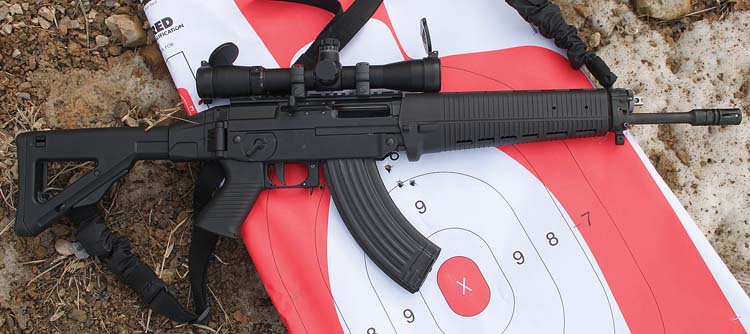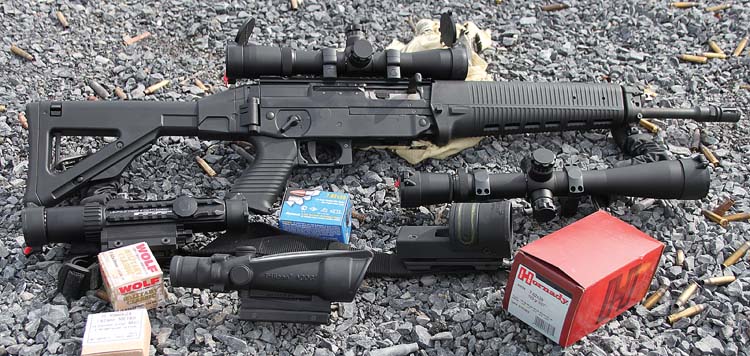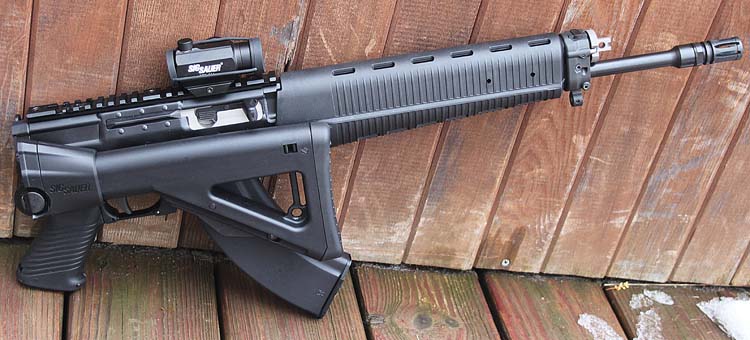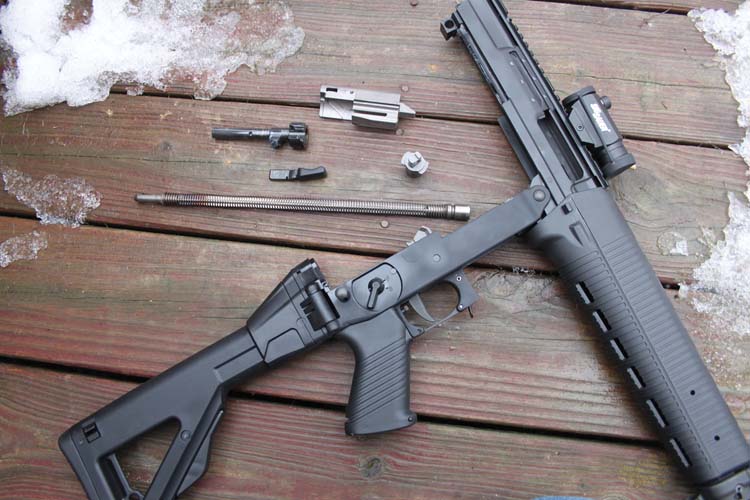The SIG Sauer 556 rifle model strikes many as a valid option to the AR-15/M16 platform ever since its introduction in the U.S. In its original offering, the SIG556 was chambered in 5.56mm with it accepting AR-15/M16 magazines – a necessity for it to have any chance in the U.S. market. What many may not realize due to the SIG556 accepting AR-15/M16 magazines is that it is closely related to the Kalashnikov AK in actual operating method. It utilizes a gas piston operating rod system with a rotating bolt and carrier very similar to the AK’s in configuration. Two major differences are quickly evident between the SIG and AK method. This first consists of the recoil spring being incorporated around the operating rod versus placed at the rear of the bolt carrier in the original Kalashnikov design. The SIG two-position adjustable gas system is the other difference allowing for the SIG not to be over pressured and thus more refined in operation.
The SIG operating rod system is often referred to as the Porsche of AK designs due to the tighter tolerances and better workmanship found in SIG weapons compared to other manufacturers using the AK as a basis of design. The gas piston operating system keeps the action cleaner, cooler, and overall more reliable. It also allows the use of side folding stocks to reduce overall dimensions of the rifle when needed. These are all positive attributes, especially considering the recent rush to create gas piston ARs due to the increased reliability factor. SIG Sauer recently fully embraced the Kalashnikov heritage by introducing the SIG556 Russian model chambered in 7.62×39. The 556 Russian accepts AK47 magazines and is a nod to the previous experience with the 556 line-up designed to accept AR-15/M16 magazines. Any new firearm introduction is more readily received if use of proprietary magazine is avoided.
Anyone looking for a hard-hitting carbine will appreciate the SIG556 Russian. The functionality of a rifle utilizing AK47 magazines incorporating a proven gas piston operating rod system with a heritage tied to the legendary SIG550 is hard to deny. SIG manufacturing quality combined with the means to mount any optic of choice on the 556 Russian’s flattop upper receiver represents the AK design coming full circle. Combining this with quick handling and an ergonomic rifle design that is easily transported, especially with the stock folded, is a further reinforcement. The SIG556 Russian integrates excellent accuracy from the 16-inch barrel with efficient handling and maneuverability. Thus, no matter the situation, whether it is a rural setting with longer distances encountered or more urban requiring CQB style tactics, the SIG556 Russian can satisfy the mission. This is due to SIG’s well earned reputation for ruggedness and reliability combined with the 7.62×39 cartridge. Lessons rediscovered in Iraq and Afghanistan about terminal ballistics serves to enhance the 7.62×39 credentials. 7.62×39 load offerings range from 122g-154gr FMJ, HP, and SP perform very similar to the .30-30 in terms of ballistic performance. A recently introduced Hornady 123gr SST offering is further proof that the AK47 has come to stay in the U.S. The Kalashnikov long-stroke gas piston operating system, especially when tweaked in the form of the SIG550 rendition, is a benchmark in terms of reliability for other actions.

The SIG556 Russian features a flat-top upper receiver with a Picatinny rail for mounting optics or other aiming devices. Recent trends in fighting rifles would indicate the design intent for the SIG556 Russian is to mount some sort of low powered magnified optic or red dot as the primary sighting tool. Along these lines a SIG STS 081 red dot optic is shipped with the rifle. It was decided that a magnified optic would better serve the SIG556 Russian.
The SIG556 Russian chambered in 7.62×39 weighs 7 pounds, measures 36 inches with the telescopic stock fully extended, 34.5 inches collapsed, and 27.1 inches folded. The folding adjustable for length stock positively latches when closed and unfolds securely for steady shouldering. The A2 flash suppressor uses a standard .5×28 thread pattern for mounting. SIG installs a two-stage trigger and ambidextrous safety on the 556 Russian. SIG uses aircraft grade aluminum alloy forgings for the lower receiver. The SIG556 Russian has a 16-inch military grade cold hammer forged barrel with 1:9.5 twist. The 556 Russian is an intriguing hybrid of AK/AR/SIG rifle features. SIG operating mechanism that is ultimately derived from the AK, using AK magazines chambered in the prototypical Soviet/Russian 7.62×39 cartridge, with AR operating controls such as bolt hold-open latch and ambidextrous safety with flattop style upper receiver for easy installation of optics.

The SIG556 Russian upper hinges open ala AR design with bolt group and gas piston removed per provided directions and trigger group exposed in the lower. Barrel/chamber cleaning is easily accessed as is the bolt group and piston operating rod. One interesting side note is that the upper of the SIG556 Russian bears the serial number of the weapon compared to the lower of the AR-15. Overall, cleaning of the SIG556-series takes little time with the bolt group needing little more than a wipe off and re-lubrication. The Nitron finish on the upper and hard coat anodized aluminum lower keeps exterior concerns to a minimum.

It was decided to take full advantage of the 556 Russian’s flattop upper by mounting multiple optics on the SIG556 Russian during testing. A 3.5x ACOG TA11H model with green horseshoe reticle was mounted on the 556 Russian to wring the most out of the rifle. Along these same lines a Leupold Mk 4 CQ/T 1-3x was also utilized. In addition to low magnification battle optics, a Leupold Mk 4 2.5-8x was employed to ascertain the 556 Russian’s accuracy potential and could be left on if individual user chose to go this route: a low power setting for quick target acquisition at close range, a turn of the knob to 8x for longer or precision shots as the mission dictates. The optic intended to be left on the SIG556 Russian after accuracy testing would be a Trijicon ACOG or Leupold Mk 4 CQ/T. The ACOG sight assisted in engaging targets at close distances with its green reticle easy to pick up rapidly. Both sights offered the capability to engage multiple targets in rapid sequence compared to open sights, while at the same time providing adequate accuracy out to a couple hundred yards. The Trijicon and Leupold reticles superimpose an aim point on the target while not totally obscuring the target due to the center dots not being that large. As many “maturing” shooters can attest to, the single focus plane reticle is easier to shoot accurately than coordinating front and rear sights. The 7.62×39 round’s trajectory is conducive to making hits out to 300 yards without having to resort to excessive hold over; 3 inches high at 100 yards produces a 200 yard zero with -15 inches at 300 yards.
Multiple 7.62×39 loads were tested with the SIG Sauer 556 Russian such as Hornady, Wolf, Barnaul, Egyptian and Yugoslavian surplus. Barnaul Silver Bear zinc-plated and Wolf Ammunition steel cased 122gr and 124gr loads hovered in the sub 3 inch range at 100 yards with surplus Egyptian and Yugoslavian 7.62×39 producing similar groups. The long anticipated Hornady 123gr SST bullet mated to steel cases are starting to arrive on dealers’ shelves and was tested with the SIG556 Russian. It seems that the original Hornady 7.62×39 loads that featured the V-Max bullet is being replaced with the SST bullet type, which represents a more controlled expansion with its bullet construction in lieu of the more varmint style V-Max construction. The SST loads delivered accuracy in the 1.5 inch range at 100 yards. The SIG556 Russian combined with Trijicon or Leupold optics mated to quality ammunition in the form of the Hornady 123gr SST is what many AK connoisseurs have been waiting for. There are many pages written in magazines and on various internet forums about what it would take to turn the 7.62×39 AK into more of a general purpose rifle. The hold-up to more effective use of the AK at ranges past 100 yards usually revolves around solid scope mounting and ammunition of greater quality than what is offered in the surplus realm. The SIG Sauer 556 Russian solves this conundrum.
Most range testing utilized the Wolf Ammunition Military Classic 124gr FMJ load. The steel cased Wolf Ammunition and brass cased surplus Egyptian/Yugo surplus ammunition performed without issue. Magazine change drills turned out to be more AK like than AR in terms of manipulation techniques. The SIG556 Russian does not have a bolt hold open feature after the last round is fired. However, a bolt hold open latch is incorporated. Magazine changes resort to either reaching over or under the rifle with your left hand to work the bolt recharging the chamber, or tilting the rifle over with the right hand on the pistol grip and work action with left hand, or switch rifle over to left hand and work bolt with right hand. None of these techniques were particularly hard to master, but different from what dyed-in-the-wool AR operators will be accustomed to. A word of hard learned experience with reloading the SIG556 Russian in that the windage knob on the Leupold Mk 4 2.5-8x scope (and most other classic turret scopes) dictates an underneath finger pull action on the SIG556 Russian’s bolt handle versus a more aggressive “grip-n-rip” pure AK style.
The folding telescopic rear stock is an immediate advantage found on the SIG556 compared to a traditional AR rifle with its buffer tube preventing a folding stock option. SIG is now using a folding stock reminiscent of the design found on the classic SIG550 compared to other types that accompanied early 556 variants. The folding telescoping stock, once deployed, is very sturdy and does not exhibit any side-to-side or up-and-down wiggle. The stock has multiple lengths of pull adjustments so a user can find what best suits individual needs, especially if wearing body armor. Multiple sling attachment points come standard on the 556 Russian, including a single point option. A BLACKHAWK! single point sling was attached for this evaluation.
Range testing commenced with functionality assessment consisting of dumping multiple magazines at several targets in rapid fashion once sight zeros were verified. Any fighting rifle, regardless of chambering, must be reliable to be worthy of consideration. Once the SIG556 Russian proved reliable, it was then put through its paces on different rifle courses of fire that were set up for a pending law enforcement competition held at Echo Valley Training Center. It was quickly ascertained that the SIG556 Russian had a much more substantial recoil impulse compared to its 5.56mm brethren. This is not hard to fathom considering the difference in cartridges. Magazine changes, shooting from the non-dominant shoulder and unconventional positions around barricades helped to evaluate the SIG556 Russian. Strings of fire ranged from 15 to 80 rounds with target distances measured in feet out to a couple hundred yards. The SIG556 Russian handled as expected from a lightweight carbine combined with perfect reliability. One nuance found with the SIG556 Russian is that it is particular about what magazines it accepts. Only steel AK and Bulgarian polymer magazines, one of these was sent with the rifle, worked in the 556 Russian evaluated herein. U.S. Palm, AK waffle pattern polymers, and drum magazines were a no-go. Along these same lines, with the magazines that do fit a fair amount of wobble is exhibited in the mag well.

Further evaluation of the SIG556 Russian was based on training experiences derived from attendance at Tactical Response and Suarez International rifle courses. Several of the more dynamic drills experienced during the Tactical Response and Suarez International courses were based on Team Tactics exercises. Team Tactic exercises involving moving to and from a designated target area using cover while either changing magazines or engaging targets when a partner is reloading are excellent weapon evaluation drills. One gets a good sense of the way a weapon handles along with reliability due to the sum of ammunition expended in short time frames characteristic of these Team Tactic drills. The full gamut of rifle manipulation is encompassed in Team Tactics training evolutions – handling around cover while engaging designated targets, accuracy to effectively strike at both distance and CQB ranges, magazine changes, and reliability once a weapon gets heated up. The growing popularity of AK products translates into ancillary items being more readily available. This is represented by two US Palm products used in conjunction with the SIG556 Russian: the AK Attack Rack and Defender Series chest rigs. The AK Attack Rack is low profile secure platform for 4 AK magazines and 4 pistol magazines. The AK Attack Rack chest rig can be worn over hard or soft body armor and is built to military specifications out of 500d Cordura nylon for durability and minimal weight. Another US Palm accessory used in conjunction with the SIG556 Russian was the Defender AK body armor rig. The Defender comes with a Level III soft armor insert with ability to install hard SAPI plates both front and rear. The Defender is US Palm’s effort to make more affordable products available to security conscious civilians or law enforcement having to purchase their own gear. The Defender AK model mounts quickly and offers body armor protection along with capability to carry three AK magazines and three pistol magazines.
The SIG Sauer decision to utilize its proven gas piston operating system derived from the SIG550 combined with accepting AK magazines is sound. While the SIG556 Russian is not going to be used by our military services or even law enforcement; it is not hard to visualize special operation forces, not to mention private contractors and security conscious civilians, wanting to take advantage of its ability to utilize 7.62×39 cartridge fed via ubiquitous AK47 magazines fired more accurately than thought possible. The SIG Sauer 556 Russian could be the answer to fulfilling a multitude of roles: DMR rifle, general-purpose patrol rifle, or even entry weapon. This is a positive reflection on what SIG is seeking to accomplish with the SIG556 Russian – accuracy, reliability, handling and ergonomics.
Sources:
SIG SAUER, Inc.
18 Industrial Drive
Exeter, NH 03833
(603) 772-2302
www.sigsauer.com
Wolf Ammunition
PO Box 757
Placentia, CA 92871
(888) 757-9653
www.wolfammo.com
US PALM/SGCUSA
14860 N. Northsight Blvd.
Scottsdale, AZ 85260
(480) 222-4369
www.uspalm.com
Hornady Mfg. Inc
3625 Old Potash Hwy
Grand Island, NE 68802
(800) 338-3220
www.hornady.com
Leupold & Stevens Inc
14400 NW Greenbrier Pkwy
Beaverton, OR 97006
www.leupold.com
Trijicon Inc.
49385 Shafer Ave
Wixom, MI 48393
(248) 960-7700
www.trijicon.com
| This article first appeared in Small Arms Review V14N12 (September 2011) |










